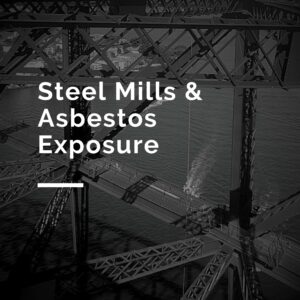From a time of control and innovation, the United States was a leader in steel production during the late 1960s. This slowly turned sour as working conditions became examined due to the number of injuries workers had suffered. Further examining these conditions revealed something darker than blatant physical materials such as infrastructure and machinery, materials like asbestos and lead along with other fibers to be inhaled we’re discovered. Steel mills and asbestos exposure go hand in hand.

While it’s recognized that asbestos was not a crucial aspect of the industry, it still made way in elements such as hot topping, and heat-generating powders that are applied to pouring cups and risers aiding in filling, or expansion sheets. The limited use of this material was attributed to its deterioration of strength and durability in extremely high heat, although heat resistant, there were other materials available that more efficiently satisfied their needs for pipes and machines.
Asbestos exposure nevertheless was available even in small quantities. The steel mills’ response to this was to follow the Occupational Safety and Health Administration protocols that were created in the early 1970s that claimed a permissible exposure limit. It was later required in the upcoming years to have medical examinations, respirators, and proper equipment for these workers.
The main types of asbestos that were used commercially were chrysolite, making up 95%, amphibole, and tremolite. The use was found in materials like gaskets, brake pads, refractory materials, clothing, and insulation. For example, asbestos blankets were used in “blast furnace operations”. While it was previously recognized that asbestos presence in these items was minimal confirmation was still required which led to the testing of these products from sampling facilities at the steel mills. The results returned low levels of asbestos concentrations. Subsequently, materials with asbestos began to be labeled with this text…
“CAUTION CONTAINS ASBESTOS FIBERS AVOID CREATING DUST BREATHING ASBESTOS DUST MAY CAUSE BODILY HARM” (Paustenbach et al.).
A few of the departments of the steel mills that were potentially affected by asbestos are listed below. Additionally, some of the steel facilities investigated for asbestos exposure are included
| Department | Steel Mill Facility |
| Blast furnace | Edgar-Thomson Plant 1972–1975 |
| Boiler house | Fairfield Works 1976–1985 |
| Central maintenance | Fairless Works 1976–1985 |
| Coke | Gary Works 1972–1975 |
| Geneva Works 1976–1985 | |
| Finishing | Homestead Works 1972–1975 |
| Foundry | Irvin Works 1976–1985 |
| Masonry | Valley Works 1976–1985 |
| Melt shop | National Duquesne Works 1976–1985 |
| Research lab | Neville Island Plant 1976–1985 |
| Pittsburg Works 1976–1985 |
The highest prevalence of asbestos was found in the blast furnace department as well as the melt shop. This can be due to the additional uses of asbestos in the activities mentioned previously such as for hot topping and expansion sheets. Regarding the physical plant itself, Gary Works, at the “U.S. Steel’s largest manufacturing plant” (IDEM), contained the highest fiber concentration. Although in Indiana, Pennsylvania was once a major player in steel, and currently “some 35,300 people currently work in the steel industry in Pennsylvania” (Federal Steel Supply).
If exposed to asbestos, there is the risk of diagnoses such as mesothelioma and asbestosis. Mesothelioma is a rare form of cancer that occurs in the mesothelial tissue. Common organs that are impacted include the lungs (pleural mesothelioma and also the most common type), abdomen (peritoneal mesothelioma), heart (pericardial mesothelioma), and the testicles (testicular mesothelioma). There are roughly 3,000 Americans diagnosed with cancer each year and some of the common symptoms that persist are persistent coughing, difficulty breathing, and chest pain. The second type of diagnosis that often occurs is asbestosis, better known as a chronic lung disease. When this occurs, “some of the airborne fibers can become lodged within…the tiny sacs inside your lungs where oxygen is exchanged for carbon dioxide in your blood” (“A Chronic Lung Disease Caused by Inhaling Asbestos Fibers-Asbestosis – Symptoms & Causes – Mayo Clinic”). Some of the symptoms that persist include clubbed fingers, chest pain, and a crackling noise in the lungs.
If you or someone you know has been affected by mesothelioma in the state of Pennsylvania, please visit The Halpern Law firm for a free consultation or call 1 (800) 505-6000 to turn today’s adversity into tomorrow’s justice.
Sources:
https://www.nature.com/articles/s41370-023-00576-4.pdf
https://www.in.gov/idem/resources/lake-michigan-sites-of-interest/u.s.-steel-gary-works/
https://www.fedsteel.com/insights/five-states-strongest-steel-industries/
https://www.mayoclinic.org/diseases-conditions/asbestosis/symptoms-causes/syc-20354637